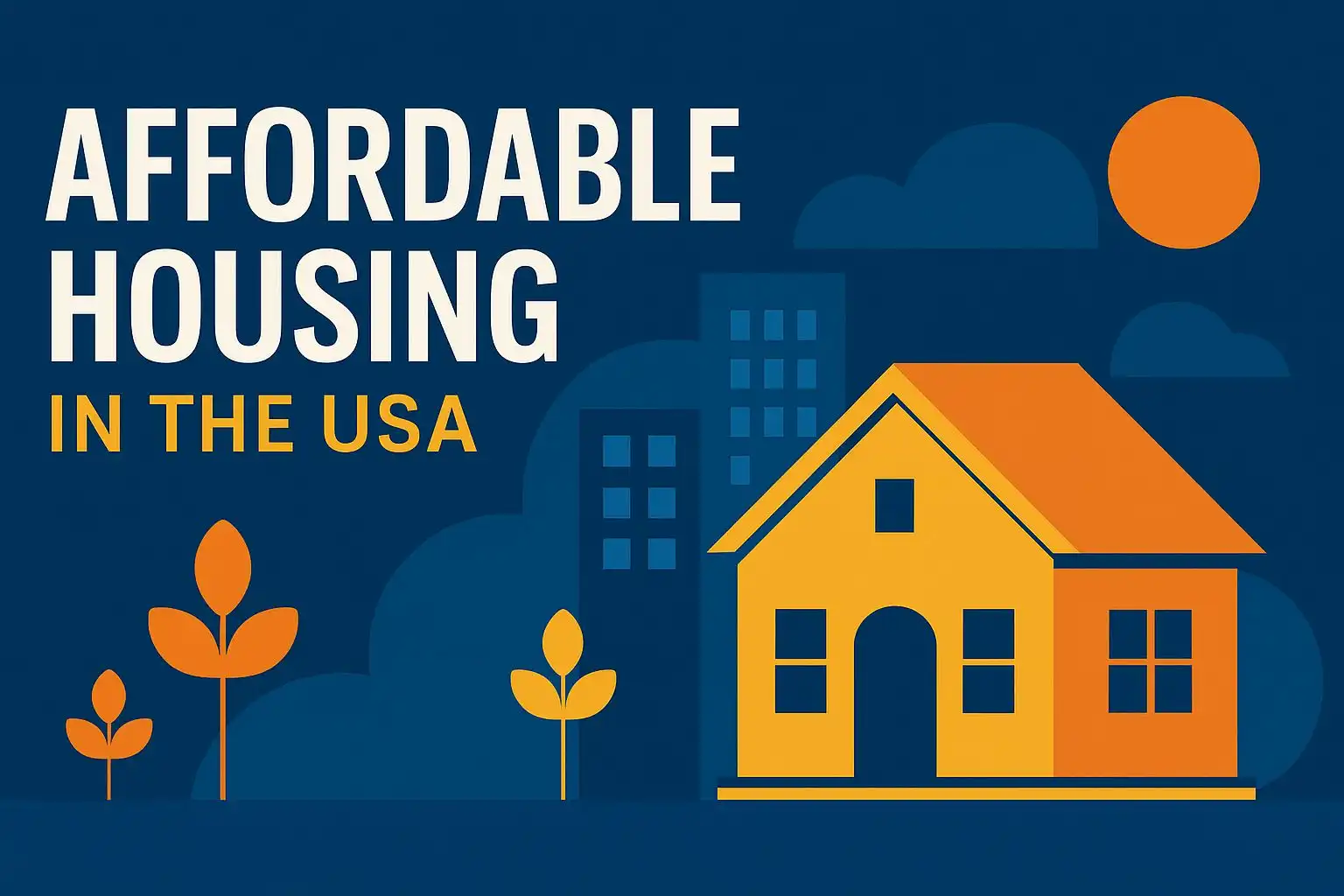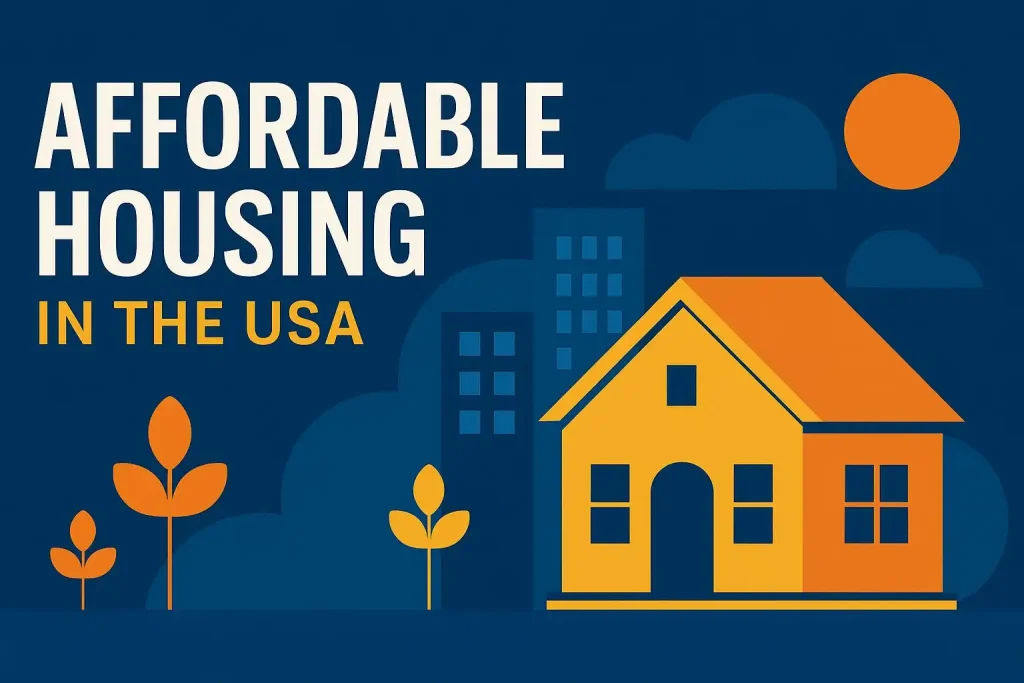Affordable Housing in the USA: Challenges, Solutions, and Future Trends
Affordable Housing in the United States | Challenges, Solutions & Future Trends 2025

Affordable housing has become one of the most pressing issues in the United States today. With rising rents, limited housing supply, and increasing demand in both urban and suburban areas, millions of Americans struggle to find homes they can reasonably afford. According to the U.S. Department of Housing and Urban Development (HUD), housing is considered affordable if it costs no more than 30% of a household’s gross income. However, for many families, especially those living in major metropolitan areas, housing expenses far exceed that threshold.
In this comprehensive guide, we will explore the state of affordable housing in the U.S., why it matters, what challenges exist, and which solutions could shape the future. From government programs to private sector innovations, this 5,000-word blogpost will serve as an in-depth resource for anyone interested in understanding the dynamics of housing affordability in the United States.
What Is Affordable Housing?
Table of Contents
Affordable housing refers to homes that are reasonably priced so that households can meet their other essential needs, such as food, healthcare, transportation, and education. The concept covers both rental housing and homeownership.
Key Definitions:
- Affordable Housing Standard: Housing costs should not exceed 30% of household income.
- Low-Income Housing: Designed for families earning below 80% of the area median income (AMI).
- Very Low-Income Housing: Targeted at households earning less than 50% of AMI.
- Extremely Low-Income Housing: Reserved for those earning less than 30% of AMI.
Affordable housing can be provided by the government, non-profit organizations, or private developers through subsidies, tax incentives, or housing assistance programs.
The State of Affordable Housing in the United States
Rising Housing Costs
Over the last two decades, housing costs in the U.S. have outpaced wage growth. For example, between 2000 and 2023, median home prices increased by more than 150%, while median wages rose by only around 50%.
Rental Housing Crisis
According to the National Low Income Housing Coalition (NLIHC), there is a shortage of more than 7 million affordable rental homes for extremely low-income households. In states like California, New York, and Florida, rents are especially high, leaving many families rent-burdened.
Homeownership Gap
Homeownership has long been considered the American dream. However, rising property prices and mortgage rates have made it increasingly difficult for first-time buyers to enter the market. Minority communities, particularly Black and Hispanic families, face even larger barriers to homeownership due to systemic inequities.
Homelessness and Housing Insecurity
The U.S. Department of Housing and Urban Development (HUD) reported that on a single night in 2023, more than 580,000 people experienced homelessness. While not all homelessness is due to affordable housing shortages, the lack of accessible, safe, and low-cost housing contributes significantly.
Why Affordable Housing Matters?
- Economic Stability: Affordable housing allows families to spend more on healthcare, education, and transportation, boosting the economy.
- Workforce Retention: Workers in essential industries (teachers, nurses, firefighters, retail staff) need affordable housing near their jobs.
- Health Benefits: Families living in stable, affordable homes experience better mental and physical health.
- Education Outcomes: Children in stable housing perform better academically compared to those facing housing instability.
- Community Development: Affordable housing fosters diversity and strengthens neighborhoods.
Key Challenges in Affordable Housing
1. Shortage of Supply
The U.S. has not built enough affordable housing units to meet demand. High construction costs, zoning restrictions, and limited land availability hinder supply.
2. Rising Rents and Property Values
With strong demand and limited supply, landlords and developers charge higher rents. Property values also increase, making homeownership less accessible.
3. Zoning Laws and Regulations
Many cities restrict multi-family housing through zoning codes, limiting density and preventing the development of affordable apartment complexes.
4. Inflation and Interest Rates
As interest rates rise, borrowing costs for developers and buyers increase, further reducing affordability.
5. NIMBYism (Not In My Backyard)
Local opposition to affordable housing projects often delays or blocks construction, especially in suburban neighborhoods.
6. Income Inequality
Stagnant wages and unequal income distribution mean that even if housing supply grows, many households still cannot afford market-rate homes.
Affordable Housing Programs in the United States
The federal government, state governments, and local municipalities have created programs to address the housing crisis.
Federal Programs
- Section 8 Housing Choice Vouchers: Provides rental assistance to low-income families.
- Low-Income Housing Tax Credit (LIHTC): Encourages private developers to build affordable rental units.
- Public Housing: Federally funded housing projects managed by local housing authorities.
- HOME Investment Partnerships Program: Provides grants to states for building and rehabilitating affordable housing.
State and Local Programs
- Rent control ordinances (e.g., New York, California).
- Inclusionary zoning, which requires developers to include affordable units in new projects.
- State housing trust funds to support low-income families.
Innovative Solutions to the Housing Crisis
1. Tiny Homes and Modular Housing
Smaller, factory-built homes are more cost-effective and faster to construct.
2. Repurposing Vacant Buildings
Unused commercial properties, like old malls or office spaces, can be converted into affordable housing.
3. Accessory Dwelling Units (ADUs)
Also called “granny flats,” ADUs allow homeowners to build small rental units on their properties.
4. Public-Private Partnerships
Collaboration between government, non-profits, and developers can accelerate affordable housing production.
5. Green and Sustainable Housing
Energy-efficient homes lower utility bills, making them more affordable in the long run.
Affordable Housing in Major U.S. Cities
New York City
- Rent control and stabilization programs help but face limitations.
- Extremely high demand, limited land, and high construction costs make it one of the most challenging markets.
Los Angeles
- Homelessness crisis linked to a severe lack of affordable units.
- The city invests in modular housing and supportive housing programs.
San Francisco & Bay Area
- Tech industry growth drives prices sky-high.
- Local governments push for density reforms and affordable housing bonds.
Houston, Texas
- Rapid growth leads to affordability challenges.
- However, Houston has more flexible zoning, which allows for creative solutions.
Chicago
- Diverse neighborhoods face gentrification, displacing long-term residents.
- The city implements inclusionary zoning to preserve affordability.
Policy Recommendations
- Expand Federal Funding: Increase support for Section 8 and LIHTC programs.
- Reform Zoning Laws: Allow more multi-family developments in suburban areas.
- Encourage Private Developers: Offer tax breaks and subsidies to incentivize affordable housing projects.
- Support Renters’ Rights: Expand tenant protections and rent stabilization measures.
- Invest in Homelessness Prevention: Increase supportive housing with wraparound services.
The Future of Affordable Housing in the U.S.
With urbanization, population growth, and economic shifts, the need for affordable housing will only intensify. Policymakers, community leaders, and developers must work together to:
- Embrace sustainable construction.
- Leverage technology for cost efficiency.
- Ensure equitable housing opportunities across racial and economic groups.
what is affordable housing apartments?
Affordable housing apartments are residential rental units designed to be financially accessible for individuals and families with low to moderate incomes. The main goal is to ensure that people can live in safe, decent, and quality housing without spending too much of their income on rent.
Generally, housing is considered “affordable” if a household spends no more than 30% of its gross monthly income on rent and utilities. When rent costs go beyond that, families often struggle to cover other essential needs like food, healthcare, transportation, and education.
Key Features of Affordable Housing Apartments:
- Income-Based Rent – Rent is often calculated based on the tenant’s income, making it manageable for different financial situations.
- Government Support – Many affordable apartments are funded or subsidized by federal, state, or local programs such as Section 8 housing vouchers, Low-Income Housing Tax Credit (LIHTC) programs, or public housing authorities.
- Targeted to Low- and Middle-Income Households – They are usually intended for families, seniors, or individuals who earn less than the area’s median income (AMI).
- Variety of Options – Affordable apartments can be in public housing complexes, privately owned buildings with government assistance, or nonprofit housing developments.
- Community Stability – They help reduce homelessness, promote stable living conditions, and support economic diversity in neighborhoods.
Why Affordable Housing Apartments Matter:
- They provide safe living spaces for people who cannot afford rising rental prices.
- They help reduce homelessness and housing insecurity.
- They allow families to allocate income toward other necessities.
- They strengthen communities by ensuring that workers, teachers, healthcare providers, and service staff can live near where they work.
In short: Affordable housing apartments are rental homes that cost a reasonable amount relative to a household’s income, making housing accessible for people across different income levels while promoting stability and equality in communities.
Who qualifies for affordable housing?
Affordable housing qualifications vary depending on federal, state, and local programs in the United States, but in general, eligibility is based on income, family size, and housing needs. Here’s a clear breakdown:
1. Income Level
- Affordable housing is usually offered to low-income and moderate-income households.
- The U.S. Department of Housing and Urban Development (HUD) defines income limits based on the Area Median Income (AMI):
- Extremely Low-Income (ELI): 30% or less of AMI
- Very Low-Income (VLI): 50% or less of AMI
- Low-Income: 80% or less of AMI
For example, if the median income in a city is $80,000, a family earning $40,000 or less may qualify for certain affordable housing programs.
2. Family Size and Composition
- Income limits are adjusted depending on household size. A family of four may have a higher income threshold than a single person.
- Households with children, seniors, or people with disabilities may receive priority in some programs.
3. Citizenship or Legal Residency
- Most federally funded affordable housing programs require applicants to be U.S. citizens or have eligible immigration status.
4. Special Groups
Some affordable housing programs are designed for specific populations, such as:
- Seniors (55+ or 62+)
- Veterans
- People with disabilities
- Survivors of domestic violence
- Homeless individuals or families
5. Background and Rental History
- Many housing authorities will review rental history, credit checks, and criminal background checks.
- Having an eviction history may affect eligibility in certain programs, though local policies differ.
6. Types of Affordable Housing Programs
- Public Housing: Owned by local housing authorities.
- Section 8 Housing Choice Vouchers: Helps pay rent in private apartments.
- Low-Income Housing Tax Credit (LIHTC) properties: Privately owned but required to offer reduced rents to eligible tenants.
- State or Local Programs: Additional assistance varies by location.
In summary: Affordable housing is mainly for individuals and families who earn below a certain percentage of their area’s median income, adjusted for family size, and who meet program-specific requirements.

Who pays for affordable housing in USA?
In the United States, affordable housing is paid for through a mix of public funding, private investment, and nonprofit contributions. No single source covers the full cost — instead, multiple stakeholders come together to make housing more affordable for low- and middle-income households. Here’s a breakdown of who pays for it:
1. Federal Government
The U.S. federal government is the largest supporter of affordable housing. Funding typically comes from:
- Department of Housing and Urban Development (HUD): Provides grants, rental assistance, and housing vouchers (like Section 8).
- Low-Income Housing Tax Credit (LIHTC): Offers tax incentives to private developers who build or renovate affordable housing.
- Public Housing Programs: Directly support housing authorities that manage government-owned rental units.
- Community Development Block Grants (CDBG): Help states and cities fund housing and neighborhood improvements.
2. State and Local Governments
States and cities also contribute to affordable housing through:
- State Housing Finance Agencies (HFAs): Provide loans, tax credits, or subsidies for affordable housing projects.
- Local Housing Trust Funds: Dedicated funds collected from taxes, fees, or bonds to support low-cost housing.
- Zoning and Land Use Incentives: Cities may reduce fees, grant density bonuses, or provide public land to lower costs for developers.
3. Private Sector
Private developers, banks, and corporations play a major role, often in partnership with the government:
- Developers: Build affordable housing in exchange for tax credits or subsidies.
- Banks and Investors: Finance projects through loans or by purchasing tax credits.
- Employers: Some companies provide workforce housing to help employees afford rent near jobs.
4. Nonprofit Organizations
Charities and community-based groups also help pay for affordable housing:
- Nonprofit Developers (e.g., Habitat for Humanity): Build or renovate homes at lower costs.
- Philanthropic Foundations: Provide grants for housing projects and tenant support services.
- Community Land Trusts: Acquire and maintain land for permanently affordable housing.
5. Tenants
While subsidies reduce costs, tenants still pay a portion of the rent:
- In many programs, households contribute about 30% of their income toward rent, with the government or another source covering the rest.
In summary: Affordable housing in the U.S. is funded by a partnership of federal, state, and local governments, private investors, nonprofit organizations, and tenants themselves. The goal is to spread costs across multiple sectors so that safe, decent housing remains accessible to families who might otherwise be priced out.
Conclusion
Affordable housing in the United States is not just a housing issue—it is a social, economic, and moral imperative. Families deserve safe, stable homes that allow them to thrive. While challenges such as limited supply, rising costs, and zoning restrictions remain, innovative solutions and stronger policy interventions can create a future where every American has access to affordable housing.
By addressing these issues at local, state, and federal levels, the U.S. can make progress toward solving one of the most significant social challenges of our time.
FAQs :
What is considered affordable housing in the U.S.?
Affordable housing means housing costs (rent or mortgage) are no more than 30% of household income.
What are the biggest challenges to affordable housing in America?
The main challenges are rising rents, limited supply, zoning restrictions, inflation, and income inequality.
What government programs help with affordable housing in the U.S.?
Key programs include Section 8 vouchers, Low-Income Housing Tax Credits (LIHTC), and public housing initiatives.
How can affordable housing be improved in the future?
Solutions include zoning reforms, public-private partnerships, tiny homes, modular construction, and repurposing vacant buildings.
>> Fastest criminal justice degree online: accelerated programs & career guide



